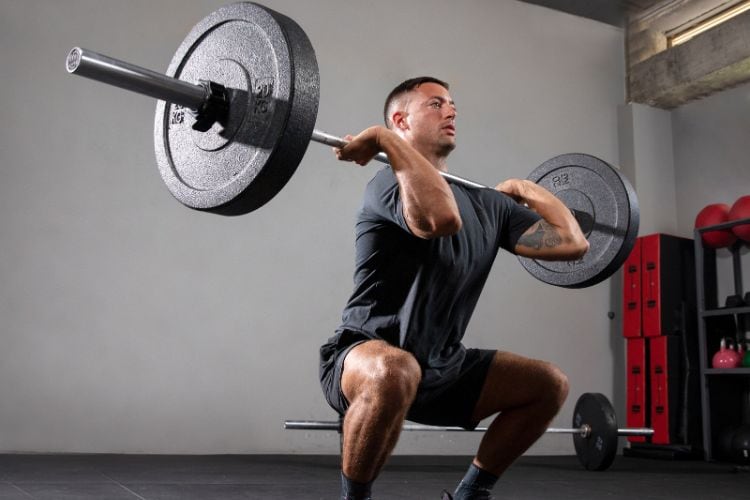
Full Body HIIT Gym Workout Plan – 45-Minute Power Circuit

Best 45 Minute Full Body Circuit Training Workout for Men

35-Minute Advanced Circuit Workout for Strength & Endurance

Best Full Body Circuit Weight Training Routine for Muscle
Barbell Front Squat Build Strength Stability and Power

The barbell front squat is one of the most effective compound exercises you can add to your training program. While it may not receive as much attention as the traditional back squat, the front squat offers unique benefits that can boost muscle growth, improve posture, and increase core stability. In this comprehensive guide, we’ll explore everything you need to know about barbell front squat workouts, including technique, benefits, variations, programming tips, and sample workout routines to help you get stronger and fitter.
What Is the Barbell Front Squat?
The barbell front squat is a lower-body strength training exercise where the barbell is held across the front of the shoulders rather than on the back. This anterior placement of the load requires the lifter to maintain a more upright torso throughout the movement, which increases activation in the quadriceps and core muscles, while reducing stress on the lower back.
Unlike the back squat, which emphasizes the posterior chain, the front squat is a quad-dominant movement, making it ideal for athletes and lifters looking to develop balanced leg strength.
Benefits of the Barbell Front Squat
1. Enhanced Quadriceps Development
Front squats place more emphasis on the quadriceps than back squats. The upright torso angle requires the quads to work harder to extend the knees, making this an excellent movement for athletes, bodybuilders, and powerlifters looking to boost front-leg strength.
2. Improved Core Strength and Posture
Holding the barbell in the front rack position activates the abdominals, obliques, and spinal erectors more than traditional squats. This reinforces core stability and promotes better posture, especially under load.
3. Reduced Lower Back Strain
Since the front squat requires a more upright torso, it naturally reduces the shear stress on the lumbar spine, making it a safer option for individuals with lower back concerns.
4. Increased Mobility
Front squats require adequate hip, ankle, shoulder, and wrist mobility, making them not only a strength movement but also a functional mobility challenge. Regularly performing this lift can improve flexibility in these critical joints.
5. Transfer to Athletic Performance
The vertical torso positioning and explosive nature of the front squat makes it highly transferable to sports-specific movements like clean and jerk, sprinting, and jumping.
Proper Barbell Front Squat Technique
Mastering the technique is essential for reaping the full benefits of the front squat while avoiding injury.
Step-by-Step Form Guide:
- Set Up the Barbell: Place the barbell on a squat rack at chest height.
- Front Rack Position: Step under the bar, placing it on your deltoids close to your neck. Your elbows should be high and pointing forward. Use either a clean grip (fingers under the bar) or cross-arm grip.
- Unrack the Bar: Stand tall, lift the barbell off the rack, and take two steps back.
- Foot Position: Stand with feet shoulder-width apart and toes slightly pointed out.
- Initiate the Descent: Inhale, brace your core, and descend by bending your knees and hips, keeping your elbows high and chest up.
- Depth: Lower until your thighs are at least parallel to the floor (or deeper if mobility allows).
- Drive Up: Push through your mid-foot and heels to return to the starting position while maintaining an upright torso.
- Repeat for Reps: Complete the desired number of reps and then safely rack the bar.
Common Barbell Front Squat Mistakes to Avoid
Even experienced lifters can make errors that hinder progress or increase injury risk. Keep these in mind:
Dropping the Elbows
Letting the elbows drop causes the torso to lean forward, shifting the weight away from the legs and increasing strain on the lower back. Keep your elbows as high as possible throughout the movement.
Collapsing Core
A weak or unbraced core leads to instability. Always brace your core before the descent and maintain tightness throughout the lift.
Rising on the Toes
This indicates poor weight distribution and may signal ankle immobility. Focus on pushing through the heels and mid-foot for proper balance.
Improper Grip
If the bar is rolling or your wrists hurt, reassess your rack position or use straps or a cross-arm grip to maintain a comfortable but secure hold.
Best Variations of Barbell Front Squats
Incorporating variations can help target specific weaknesses or add variety to your training.
1. Pause Front Squat
At the bottom of the squat, pause for 2–3 seconds before ascending. This removes momentum and increases time under tension, boosting strength and control.
2. Tempo Front Squat
Slow down the eccentric (lowering) portion of the movement to 3–5 seconds. This challenges your stability and builds muscular endurance.
3. Zombie Front Squat
Performed by extending your arms straight out in front, with the bar resting on your shoulders. This variation forces perfect form and punishes forward leaning.
4. Front Box Squat
Use a box to control depth and form. This is ideal for beginners or those training for explosive power.
5. Front Squat with Chains or Bands
Adding resistance bands or chains helps improve explosiveness by increasing resistance at the top portion of the lift.
Sample Barbell Front Squat Workout Routines
Whether you’re training for hypertrophy, strength, or conditioning, these barbell front squat workouts will help you progress effectively.
Beginner Front Squat Workout (2 Days/Week)
Day 1: Strength Focus
- Front Squats: 3 sets x 5 reps
- Dumbbell Step-Ups: 3 x 10 reps/leg
- Romanian Deadlifts: 3 x 12
- Plank: 3 x 30 seconds
Day 2: Volume Focus
- Front Squats: 4 x 8 reps
- Walking Lunges: 3 x 12 reps/leg
- Leg Curls: 3 x 15
- Hanging Leg Raises: 3 x 10
Intermediate Front Squat Program (3 Days/Week)
Day 1 – Heavy Day
- Front Squat: 5 x 3 (85–90% 1RM)
- Barbell Lunges: 3 x 8
- Box Jumps: 3 x 6
- Cable Crunches: 3 x 12
2 – Speed & Power
- Pause Front Squat: 4 x 4
- Kettlebell Swings: 3 x 15
- Split Squats: 3 x 10
- Russian Twists: 3 x 20
3 – Hypertrophy
- Front Squat: 4 x 10
- Leg Press: 3 x 15
- Glute Bridges: 3 x 20
- Decline Sit-Ups: 3 x 15
Advanced Front Squat Routine (Strength Block)
Week 1–4: Linear Progression
- Front Squat: 3×5, add 5–10 lbs per week
- Deadlift: 4×5
- Hip Thrusts: 3×12
- Ab Rollouts: 3×15
Week 5–8: Intensity Cycle
- Front Squat: 5×3 @ 90% 1RM
- Bulgarian Split Squat: 4×8
- Broad Jumps: 3×5
- Weighted Planks: 3×30 sec
Tips for Maximizing Front Squat Progress
Warm Up Thoroughly
Don’t jump straight into heavy sets. Start with 5–10 minutes of cardio, followed by mobility drills for your ankles, hips, and shoulders. Then perform bodyweight squats and warm-up sets.
Use Proper Shoes
Lifting shoes with a slight heel can significantly improve front squat mechanics by aiding in ankle mobility and upright posture.
Track Your Progress
Keep a workout log of sets, reps, and weights. Monitor weekly improvements, and consider testing your 1-rep max every 6–8 weeks to measure strength gains.
Train Your Mobility
Daily stretching and mobility work, especially for your wrists, lats, hips, and ankles, will help you maintain a solid front rack position and hit full depth consistently.
Barbell Front Squats vs. Back Squats: Which One Is Better?
The debate between front and back squats is ongoing, but each serves a unique purpose:
| Feature | Front Squat | Back Squat |
|---|---|---|
| Quad Activation | High | Moderate |
| Glute/Hamstring Activation | Moderate | High |
| Core Engagement | Very High | Moderate |
| Load Tolerance | Lower | Higher |
| Spinal Load | Lower | Higher |
| Mobility Requirement | Higher | Lower |
Verdict: Incorporate both front and back squats for complete lower-body development. Use front squats for quad and core emphasis, and back squats for posterior chain and maximal strength.
Who Should Do Barbell Front Squats?
Barbell front squats are beneficial for:
- Athletes: To improve vertical jump, sprinting, and clean technique.
- Bodybuilders: To emphasize quad hypertrophy and core aesthetics.
- CrossFitters: A functional staple in WODs and Olympic lifting.
- General Lifters: A safe alternative to back squats with excellent strength and mobility benefits.
- Beginners: Especially those with lower back concerns or those developing form.
Add Barbell Front Squats to Your Routine
The barbell front squat is a powerhouse lift that deserves a permanent place in your training regimen. Whether you’re looking to build leg strength, improve posture, enhance athleticism, or protect your lower back, this movement checks all the boxes.
Start with proper form, progress with structured programming, and stay consistent. Your legs (and core) will thank you.
Most Recommended
Subscribe to our Newsletter
Stay up to date on the latest men’s health, fitness and lifestyle trends and tips.
About Us
Men’s Fit Club was started with the goal of empowering men to get the most out of their lives. This meant going beyond exercise and diet tips to really address the broad range of issues that men face on a daily basis – topics like recreation, finding love, sexual health and even sound fashion advice.
Quick Links
© COPYRIGHT MEN'S FIT CLUB 2025. All Rights Reserved

